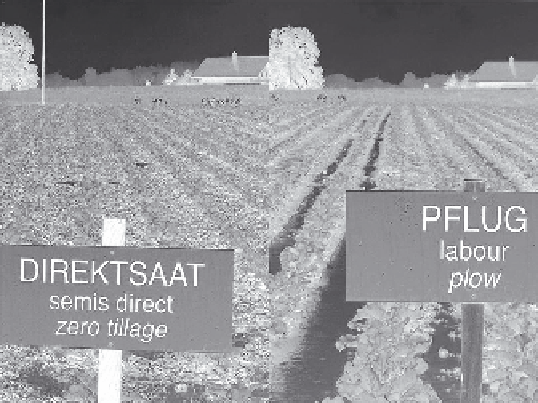Agriculture Reference
In-Depth Information
(a)
(b)
FIGURE 14.1
Soil compaction and loss in water infiltration ability caused by regular soil
tillage leads to impeded drainage and flooding after a thunderstorm in the plowed field (b)
and no flooding in the no-till field (a). Photograph taken in June 2004 in a plot from a long-
term field trial “Oberacker” at Zollikofen, close to Berne, Switzerland, started in 1994 by
SWISS NO-TILL. The three water-filled “cavities” in the no-till field were derived from soil
samples taken for “spade tests” prior to the thunderstorm. (Courtesy of Wolfgang Sturny.)
•
Poor adaptability to climate change and its mitigation.
•
Higher production costs, lower farm productivity and profit, minimal eco-
system services, and abandoned and desertified farmland and landscapes.
Smallholder farmers in developing regions using manual labor to till the land
and burning or removing all crop residues from the field also experience the above
consequences and remain trapped in a degrading vicious cycle that cannot be broken
just by applying mineral fertilizer and replacing traditional varieties with the latest
breeding results. This also applies to farms in industrialized regions where the voices
demanding more sustainable farming practices, both environmentally and economi-
cally, are getting louder. As soil degradation advances, the need for purchased inputs
increases until the point where compensatory effect is no longer possible, forcing
farmers to use even higher inputs with equally higher environmental impact.
According to Derpsch (2004), research on “conservation” or reduced tillage with
early versions of a chisel plow was initiated in the Great Plains in the 1930s to alle-
viate wind erosion. Stubble mulch farming was also developed and can be seen as
a forerunner of no-tillage farming. This collection of practices led to what became
known as conservation tillage, which includes a range of tillage practices from high
soil disturbance tillage to low soil disturbance that maintains at least 30% soil cover.
The topic
Ploughman's Folly
by Edward Faulkner (1945) was an important mile-
stone in the development of sustainable soil management for agriculture. Faulkner
questioned the wisdom of plowing and explained the destructive nature of soil tillage.
Further research in the United Kingdom, the United States, and elsewhere during the

Search WWH ::

Custom Search